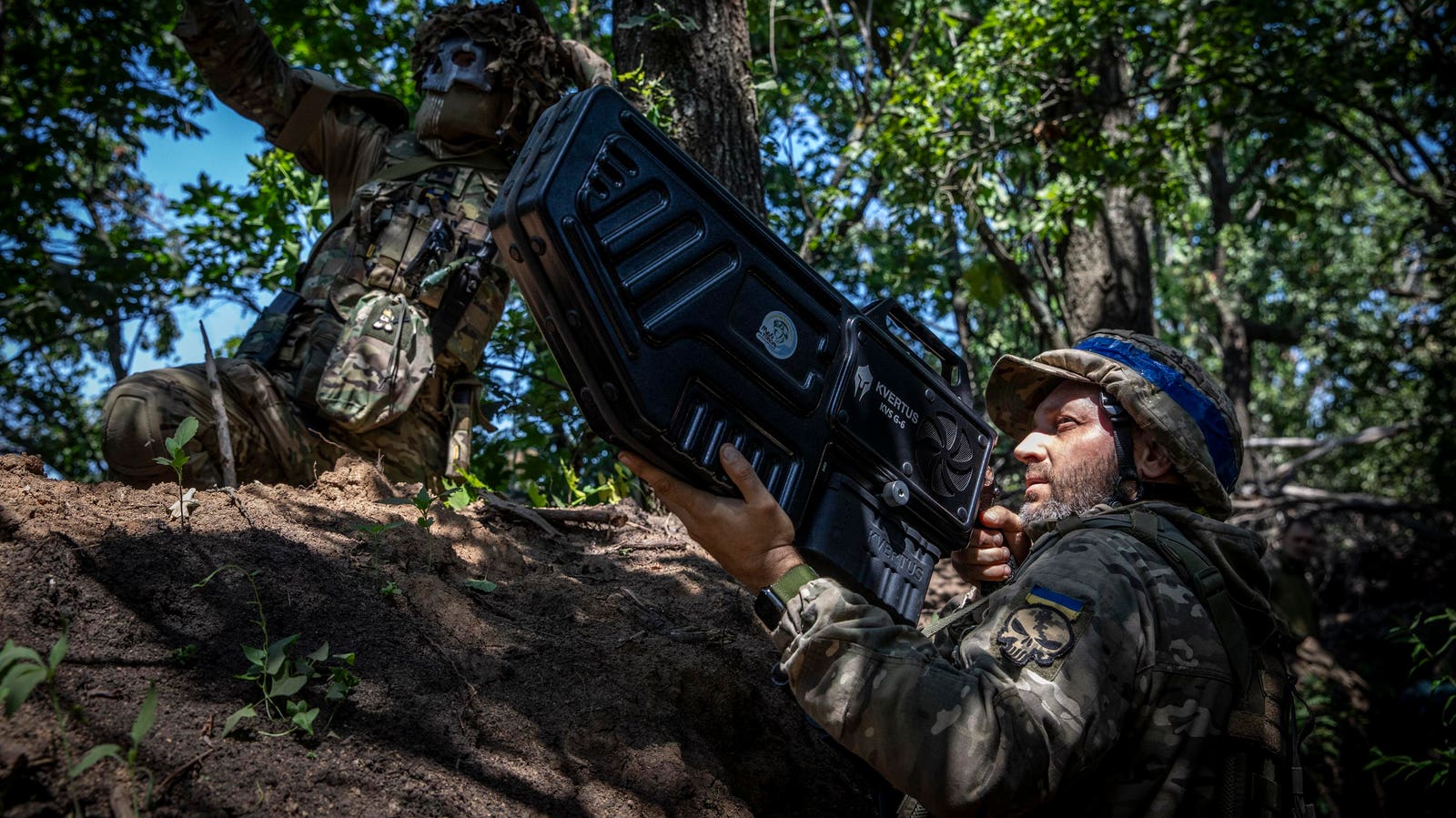
Drone and counter-drone technologies have become critical tools on the modern battlefield, with the outcome of conflicts increasingly hinging on the superiority of these systems. Recently, both Ukraine and Israel have faced challenges on their respective battlefields due to the effective usage of drones by their adversaries. Russian drones have played a significant role in hampering the Ukrainian counter-offensive. Meanwhile, a Hamas drone attack was used to launch their October 7 assault on Israel. While the focus has been primarily on the effectiveness of the drone systems, equally important is the limitations of modern counter-drone systems. Ukraine and Israel both have counter-drone systems; however, these systems have limitations that were exploited by their adversaries.
A surveillance tower called « Sentry » made from the company Anduril and used to track hostile … [+]
AFP via Getty Images
Most modern militaries, including Ukraine and Israel, have invested heavily in counter-drone technology. Indeed, modern air-defense systems, surface-to-air missile systems, and large-caliber machine guns are now fairly effective against larger drones. A major challenge arises with smaller drones, especially those that fly at lower altitudes, which are difficult to detect or target. Both countries have an array of specialty counter-drone systems in their arsenals to neutralize these drones.
Counter-drone systems are generally categorized as kinetic or non-kinetic. Kinetic systems fire projectiles, such as bullets or missiles, at a drone to destroy it. Most kinetic counter-drone systems incorporate a sensor, such as radar, to detect the drone and a motorized platform to aim and fire the weapon. Meanwhile, non-kinetic systems disrupt a drone’s flight capabilities by blocking or corrupting the signals crucial for control and navigation. These systems emit noise signals at set frequencies commonly used for controlling drones, rendering the drone incapable of detecting its command signals amidst the noise. They may also transmit false GPS signals, confusing the drone’s systems and disrupting any pre-loaded flight plans. It is worth noting that it is difficult to jam the drone’s transmission signals since this signal is considerably stronger than the command signals.
NOVODARIVKA, UKRAINE – 2023/07/05: Viking and Dimas from the 110th Territorial Defense Brigade seen … [+]
SOPA Images/LightRocket via Getty Images
Given the Russian usage of drones, many aid packages to Ukraine have included counter-drone systems. For example, the list of equipment provided by the United States to Ukraine includes several systems including counter-drone gun trucks, laser-guided rocket systems, and “other c-UAS equipment.” Additionally, they have included electronic warfare equipment, which likely incorporates non-kinetic counter-drone technology. Ukraine also recently received several CORTEX Typhon systems from Kongsberg, a Norwegian company; these systems use radar to detect drones, and then fires missiles to shoot them down. Moreover, images from Ukraine show soldiers carrying “anti-drone rifles” which are a non-kinetic system that sends a directed radio pulse to disrupt a drone.
Israel has emerged as a notable player in the counter-drone sector, using the Rafael Advanced Defense Systems Drone Dome and the Elbit Systems ReDrone. These systems are non-kinetic, detecting a drone through 3D radar, signal detection, or cameras, and then emitting jamming signals to disrupt its operation. Newer versions of the Drone Dome also include lasers for destroying the drone. The Drone Dome and ReDrone systems are used by a number of other countries to protect critical infrastructure from drone attacks and are generally considered fairly effective at neutralizing drones.
Despite these systems, there is an inherent challenge in counter-drone technology. The commercial drone market is advancing rapidly, and counter-drone technology is often lagging behind it. As drones develop new capacities, they can be used for mission sets where counter-drone systems are ineffective. In this case, Russia and Hamas deployed their drones for missions where Ukrainian and Israeli counter-drone systems would be limited in their effectiveness.
This handout photo taken from video released by Russian Defense Ministry Press Service on Monday, … [+]
Russian Defense Ministry Press Service
Notably, the Russians are using drones to patrol their obstacle belts, such that if the Ukrainians attempt to breach the obstacles, they will shoot them with artillery. Non-kinetic systems would likely be ineffective at jamming the transmission signal from the drones. Moreover, Russian drones such as the Orlan-10 have advanced autonomous flight capabilities that will limit the effectiveness of jamming. Should the Ukrainians deploy a kinetic counter-drone systems against these drones, the Russian electronic warfare teams would pick up the radar signals and target those locations with precision artillery. As such, it is difficult to counter these drones, which in turn has slowed down the Ukrainian counteroffensive.
A picture taken on March 14, 2017 in the northern Iraqi city of Mosul shows a drone carrying two … [+]
AFP via Getty Images
During the October 7th attack on Israel, Hamas strategically used drones to target Israeli defenses including security towers and communication towers using modified commercial drones laden with explosives. These drones have the ability to fly low, allowing them to not be picked up by radar. Additionally, they likely shifted to radio frequencies that are not detected or jammed by counter-drone systems. Moreover, these attacks took place in urban areas, where the utility of counter-drone systems is generally restricted. Buildings naturally obstruct line-of-sight, complicating drone detection and interception. Meanwhile, the use of non-kinetic systems is also constrained in urban environments to avoid interference with the local population.
The counter-drone challenges faced by Ukraine and Israel underscore the cat-and-mouse dynamics between drones and counter-drone technologies. Commercially empowered drone technology is evolving at a rapid pace, outpacing the progress in counter-drone technology, primarily driven by the military sector. With one country develops and deploys new counter-drone systems, their adversaries adapt by identifying weaknesses and devising strategies to circumvent them. The next round of counter-drone systems for Israel and Ukraine will likely attempt to overcome the challenges they currently face. In turn, the drone strategies of their respective adversaries will change as well, and the sequence continues.
